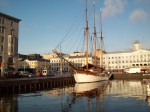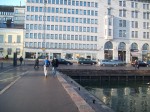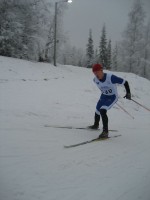Pavel Sotskov is a recent Dartmouth College graduate who had been training and working in New Zealand for the summer at the Snowfarm. After leaving New Zealand he returned to Presque Isle, ME to race for MWSC and is now with the team in Finland training for US Nationals and the Super Tour season. He has sent several updates on his experiences.
The second leg of my journey in Finland as part of the Maine Winter Sports Center saw significant increases in snow, significant decreases in daylight, and three highly competitive FIS races which brought strong results alongside great experiences for all the members of the group.
After a week of on-snow time at the world famous Vuokatti Sport Hotel, the team and I rented a Sprinter van and made the 6-hour journey deep into the heart of the Arctic Circle to the Olos Ski Resort in Muonio, Finland. There was a moment of Finnish lost-in-translation, as the van had advertised, “internet, GPS, gaming” on its rear doors. We found all this was available only if you used the van to transport yourself to an internet café. Yes, in that instance I suppose we could have had all three digital marvels, but I found it a bit strange to have this advertised on this particular vehicle.
The cross-country trails at Muonio serpentine around a small two-lift alpine hill, which served as the start and finish stadium and the main spectator zone for the racecourse. The trails are, per Finnish standard, lit until 10pm, and mainly consist of rolling, and gradual terrain. The only exception to this description is a 2km hill to the top of the alpine ridge, which was used as the only real climb in the distance races. Higher up the ridge, weather patterns generate enough wind to warrant a small wind farm, complete with 6 full size turbines.
Apart from the Finnish contingent of national team members, the communal dining hall had tables reserved for about 6 other nations, including the US flag set out for the “Team USA/New Zealand” group, which we quickly figured out was meant for our use. It is hard to communicate to a non-English speaking receptionist that you are in fact a team from the US and not the team from the US, so we left the nameplate stay. The bigger problem was the omission of the New Zealand flag for the actual NZ national team of Ben Koons and Nat Englem. Perhaps in the upcoming years the resort will invest in a Kiwi flag for the influx of the nation’s skiers visiting their restaurants.
Dining was of course not the main reason we had traveled to Muonio – instead we were all preparing for the high level of competition in the annual early season three-race series. Teams from all over the globe in search of early racing were converging on the small resort town. In addition to the traditionally strong skiing nations of Finland, Sweden, Russia, Germany and Japan, highly competitive racers from the former Soviet Union states of Ukraine, Belarus, Latvia, and Lithuania were also on hand. Andrey Golovko (formerly of the Salomon/Factory Team), was present, alongside 40 of the top racers from his country of Kazakhstan to train and compete in these races. Even countries like Turkey, Macedonia, Portugal and Kenya fielded athletes for the event.
I was very surprised to hear the story of Kenya’s Philip Boit who told us that he has been on snow for a grand total of 3 months since his skiing debut at the 1998 Winter Olympics in Nagano. Boit lives and works at his family farm in Kenya, and only visits the Northern Hemisphere for races during the winter months. His ski-specific training is not only limited by the obvious absence of snow in Africa, but also by inadequate access to roller skiing in his home country. Considering the limitations, his performance at the races in Muonio was quite good, managing to edge out several skiers who reside and train in more favorable climates.
In all, the weekend proved very successful for the Maine Winter Sports Center athletes. Nick Kline proved once again his strong knack for sprinting, while Ben Koons posted a mid-90 FIS point races, easily qualifying himself for the New Zealand national team, and earning a spot on the 2010 Vancouver Olympic Team. I skied the lowest FIS-point race of my career in the 15km skate race, at 103 points. Speaking of high levels of competition, this was definitely the first race that I have ever skied in where my place (127th) was higher than the final point score. Ben and my achievements came partially due to some fast Salomon Equipe 10 skis. I felt significantly more stable and confident on the new skis – something that I have been noticing more and more as I test the new fleet. This added to the insanely fast forward acceleration helped me ski past several world-class skiers in this race.
After the races we returned back to Vuokatti for a few days of training before our transcontinental journey home. Nat, Ben and I toured the lamp-lit 30km loops, which by that time were covered with enough snow to pack a classical track. The trail crews were busy extending the man-made loop to 10km, and training life at the Sport Hotel was continuing as before. The only problem that arose to keep the athletes from a completely idyllic life was the constant on-again, off-again operation of the wireless internet. In the days of constant online activity, the hotel lounge saw the ebb and flow of athletes more by the availability of internet than by their training schedule. I am almost positive I saw several Japanese athletes skipping practice after a painful night of “limited or no connectivity”.
On the trip back to the states, the team stopped over in Helsinki. Our tourist outing included some winter hat shopping and snacks at the local market, and a stop at views of the Helsinki waterfront.
(Some of these pictures have been shamelessly borrowed from NicholasKline.com)










